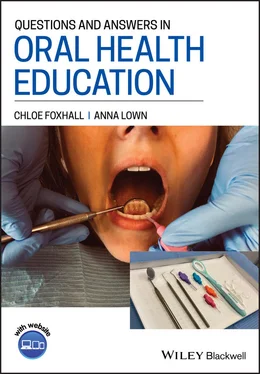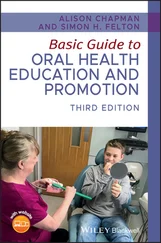Anna has written NEBDN training courses as well as CPD courses for other companies. She has also been involved with course development and oral health education for other healthcare sectors.
She enjoys family holidays in the Lake District, hiking, and reading.
Anna welcomes any comments or interest from readers. Please contact her via her website: www.smilesdentaltraining.co.uk
This book is designed to be an invaluable revision tool to assist students who are undertaking their Certificate in Oral Health Education and help to prepare them for their upcoming exam.
It provides an outline of the core topics that an oral health educator would be expected to have knowledge and understanding of and should be used as a revision tool alongside lecture notes and textbooks relating to oral health education. This book is intended as a resource to test the level of knowledge and understanding, while giving in‐depth descriptions of the correct answers for each question. It also demonstrates multiple choice questions and extended matching question formats to help preparation for the final exam.
The book contains chapters on areas such as Oral Health Messages, Anatomy and the Oral Mucosa, Sugars, Lesson Preparation, and Communication. The wide range of topics covered will help underpin the knowledge required to be able to successfully pass the oral health education exam. It has been carefully designed to be easy to use through separating each topic into revision sections, which are then divided into question and answer format.
We hope that this book provides guidance and support to you during your studies and we thank you as our readers and students. We wish you all the best in your dental career.
How to use Question and Answers in Oral Health Education
This book has been written based on two styles of questions: multiple choice questions and extended matching questions that are used in the National Examination Board for Dental Nurses (NEBDN) Post Registration Qualification in Oral Health Education exam. Students should read through this section of the book before using it as a revision guide in order to gain the best possible understanding of how the questions are prepared.
This book is designed to aid revision for students wanting to progress their knowledge in oral health education.
Multiple Choice Questions (MCQ)
Multiple choice questions are usually a one‐ or two‐line question that has several possible answers. They usually will provide some subject matter in the first line and the second line will ask the question; sometimes these will be combined. The answers will be written in alphabetical or numerical order and only one answer will be correct. Each question is worth one mark.
All of the questions are written in the same format; therefore, the student will need to have the relevant knowledge to apply to the scenario of the question in order to answer it correctly and score one mark.
During the exam, the student will have a marking sheet on which their answers should be marked in pencil with a single horizontal line through the appropriate square. Only one box should be marked for each question otherwise the computer marking system will reject the student's answer for that question and will leave the student without a mark. The marking system will also reject any question that is marked with a cross (x), a tick (✓), or a circle (◽).
Extended Matching Questions (EMQ)
Extended matching questions are in the same format as the multiple choice questions; however, the student is often given a scenario to provide background information, and then follows the question. There are a minimum of six answers to choose from, usually at least 8, and the same option list is used for at least two questions. Each of the lists of answers are based around one topic.
The student will mark the answers on a marking sheet in pencil with a single horizontal line through the appropriate square. Only one box should be marked for each question otherwise the computer marking system will reject the student's answer for that question and leave the student without a mark. The marking system will also reject any question that is marked with a cross (x), a tick (✓), or a circle (◽).
All of the questions are written in the same format; therefore, the student will need to have the relevant knowledge to apply to the scenario of the question in order to answer it correctly and score one mark.
About the Companion Website
This book also has a companion website:
www.wiley.com/go/foxhall/oral‐health‐education 

This website includes:
Multiple choice questions
Extended matching questions
Sample questions and keywords
Videos
Roles and Responsibilities
In a dental practice there are many people that make up a team in order to have a well functioning unit. This includes dentists, hygienists, therapists, and dental nurses. Clinicians are able to take on further studies and become specialists in various other fields, such as oral surgery or endodontics. Dental Care Professionals (DCPs) are now able to study to hold extended duties. Some examples of these are oral health education, radiography, sedation nursing, impression taking, or implant nursing.
A student spends five years completing undergraduate training at a university dental school. When the final examinations are completed, the students are awarded a Bachelor of Dental Surgery (BDS) which then allows them to enrol onto the dentist register with the General Dental Council (GDC). The register is held by the GDC and contains the dentist's full name, GDC number, and qualifications; the register is made public so patients can access these details.
Dentists that are registered have many opportunities to progress in the profession depending on their interests. Some of the options they have depending on location are:
general practice, either NHS or private
community dental services
educational services
armed forces
hospital services.
A dental nurse is trained to work alongside the dentist and support them while servicing patients in whichever area they decide to work; this could be in a general practice, NHS, or private, community dental services, armed forces, or hospital services. Before 2008, dental nurses were not classed as a registered profession. A dental nurse at that time could be recruited and work without any education or professional qualification. Now, a dental nurse – on completing their qualification with an accredited course provider – must register with the GDC in order to continue working. This registration is then renewed every year in order to continue working in the profession.
A dental nurse role should include, but is not limited to, the following:
Performing chairside assistance to a dentist, hygienist, or therapist throughout all procedures safely and effectively and in accordance to the GDCS scope of practice and your level of training.
Following practice policies and procedures.
Maintaining indemnity and registration with the GDC.
Undertaking CPD in line with the GDC guidelines for E‐CPD.
Maintaining and promoting productive working relationships with colleagues.
Читать дальше














